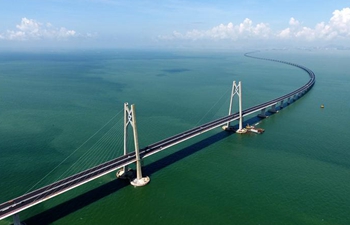WASHINGTON, March 1 (Xinhua) -- Molecular engineers from University of Washington have used a computer program to design and create complex, custom-designed transmembrane proteins not found in nature to perform specific tasks.
The study, published on Thursday in the journal Science, has shown that scientists are able to manufacture the designed transmembrane proteins inside bacteria and mammalian cells by using as many as 215 amino acids, which are proved to be highly thermally stable and able to correctly orient themselves on the membrane.
Peilong Lu and his colleagues used the computer program named Rosetta that could predict the structure a protein will fold into after it has been synthesized.
A protein's shape forms from complex interactions between the amino acids and between the amino acids and the surrounding environment, but it finally achieves the lowest possible energy state. The program can predict a structure with the lowest energy state from tens of thousands of model structures.
But the real challenge is that portions of transmembrane proteins must pass though the membrane's interior, which is made of oily fats called lipids.
Transmembrane proteins that act while embedded within the cellular membrane, are proven to be more difficult to study than proteins that operate in the watery solution that make up the cells' cytoplasm or in the extracellular fluid.
In aqueous fluids, polar or non-polar amino acid residues can separate since the polar ones are hydrophilic or "water-loving," and the non-polar ones are hydrophobic or "water-fearing," so those water-loving ones tend to be located on the surface of the proteins where they can interact with water and the water-fearing ones to be found packed within the protein core, away from the aqueous fluids.
The protein folding in membranes is complicated because the lipid interior of the membrane is non-polar, thus making no separation of electrical charges. Therefore, a stable protein must place non-polar, water-fearing residues on its surface and pack its polar, water-loving ones inside, just opposite with that in aqueous fluids.
Lu's team managed to design proteins in which the polar, hydrophilic residues fit in such a way that enough would form polar-polar interactions that can tie the protein together from within.
Researchers compared putting together these "buried hydrogen bond networks" to putting together a jig-saw puzzle.
Like naturally occurring transmembrane proteins, the designed proteins can traverse the membrane several times, and assemble into stable multi-protein complexes, such as dimers, trimers and tetramers.
"We have shown that it is now possible to accurately design complex, multi-pass transmembrane proteins that can be expressed in cells. This will make it possible for researchers to design transmembrane proteins with entirely novel structures and functions," said Lu.
According to researchers, many transmembrane proteins act as gateways for the movement of specific substances across a biological membrane, and some of them receive or transmit cell signals, so many drugs are designed to target transmembrane proteins and alter their function.

















